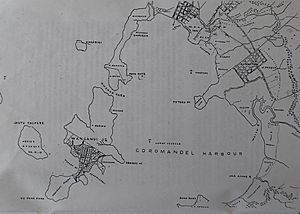Whanganui Island facts for kids
| Geography | |
|---|---|
| Location | Hauraki Gulf |
| Coordinates | 36°47′S 175°26′E / 36.783°S 175.433°E |
| Area | 2.83 km2 (1.09 sq mi) |
| Administration | |
| Demographics | |
| Population | ? |
Whanganui Island is the biggest island in a small group located at the entrance to Coromandel harbour. This harbour is part of the Hauraki Gulf, which is off the coast of New Zealand's North Island.
The island is privately owned and covers about 2.83 square kilometers (1.09 square miles). A lot of the island is used for farming, but it also has some beautiful forested areas.
Contents
Island's Early History
Long ago, there was an old Māori fort, called a pa, named Horokino (also known as Herekino). It was located at Arapaoa Bay (which is now called Homestead Bay). This pa was taken over by the Tainui people from the original inhabitants, the Ngati Huarere. Many such pa dotted the edges of Coromandel Harbour, which was then known as the Waiau.
Changes in Island Names
Over time, the names of places on Whanganui Island have changed a lot. This can make studying its history a bit tricky!
A historian named A. V. Piesse studied these names. He found that the island was originally called Poroporo. Later, early settlers called it Arapaoa, and then finally Whanganui Island. The very southern tip of the island, now called Tawhiti Point, was also once named Poroporo. The name Tawhiti Point was first used for the northern end of Tawhiti (Woolshed) Bay, which is now called Rodney Point. The island was also known by other names like Beesons Island, Parker Island, and Waihou.
In 1836, an American named William Webster started a business on the island. He built ships and traded goods. He owned the island until the Treaty of Waitangi was signed. After the Treaty, all land titles passed to the British Crown, and William Webster lost his legal ownership of the island.
During William Webster's time, a famous person named John Logan Campbell also spent some time on Whanganui Island. There's some debate about exactly where he stayed. Some say he lived at Timber (Woolshed) Bay, while others say he stayed at the home at Arapaoa Bay. There was a lot of shipbuilding happening at Timber (Woolshed) Bay, which interested Campbell. However, historian Piesse included a sketch of Campbell's "base" in his book, and Campbell himself wrote about his "Stay at Herekino" in his book "Poenamo."
Original Coromandel Town Site
Did you know that Whanganui Island was first chosen as the site for the new Town of Coromandel? Plans for the town were drawn up and sold in New Zealand and Britain.
Sections of land were sold to people. However, there was a big problem: the plans made the land look flat, but it was actually very hilly! Also, there was no good, lasting source of fresh water.
Because of these issues, the new owners gave up their land. Eventually, the Crown (the government) bought back almost all the sections. They then helped the settlers move to a new location on the mainland called Kapanga, which became the actual Coromandel Town.
Visiting Whanganui Island
Woolshed Bay, located on the island's protected southern shore, is a popular spot. Many people who are sailing from Auckland like to anchor their boats here overnight.







